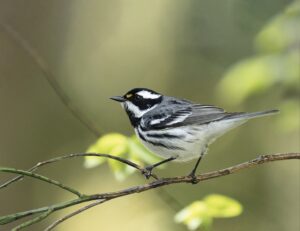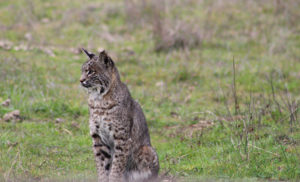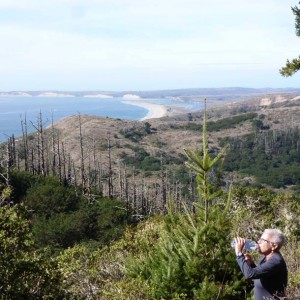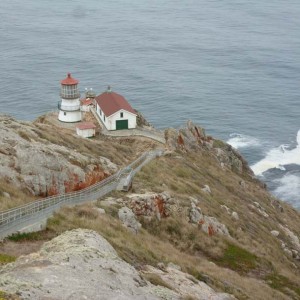“To find new things, take the path you took yesterday.” —John Burroughs
I was thinking about John Burroughs, “the Grand Old Man of Nature,” as I walked the trails that climb from Bear Valley up to Inverness Ridge. Although I’ve covered this terrain in years past, today it seems new, freshened. Maybe I’ve never been here in early August when fog mantles the ridge as it does today. Moisture drizzles through the forest canopy, pattering on the broadleaves of the huckleberry and sword ferns. The fine needles of the Douglas-fir, tightly arranged in tight rows, are effective at combing condensation from the fog. It feels like a rainforest, and in fact it is. Inverness Ridge is arguably the southern-most extent of the Pacific temperate rain forest that stretches southward from Alaska’s Prince William Sound. The rainfall at Park headquarters in Bear Valley is about 40 inches a year, but just upslope in the Douglas-fir forest the summer fog drip might add another 20 inches of precipitation in summer.
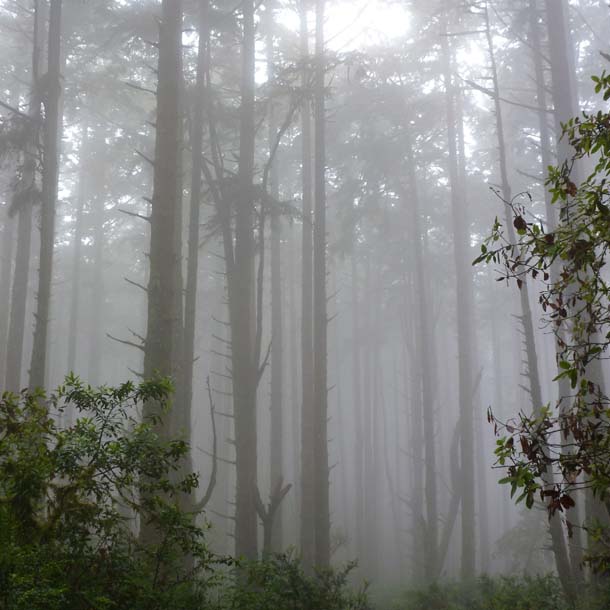
Soundscape ecologist Bernie Krauss calls the symphonies of natural environments “biophony,” and developed a “niche hypothesis: the healthier the habitat, the more musical the creatures, the richer and more diverse their scores.” Soundscape complexity is a measure of an environment’s health. He’s right.
But the forest is relatively quiet in early August. With the gradually shortening days, most birds have ceased singing. No longer preoccupied with attracting mates or defending territory, they are busy attending recently fledged chicks, or conserving energy as they go through “postnuptial” molt, restoring their plumage, replacing worn feathers with new ones. Of course, you can always count on the policeman of the forest, the Steller’s jay, to announce your arrival with a harsh, scolding “scraaw, scraaw, scraaw,” but otherwise, the only sound is the perpetual patter of the fog drip through the needles and the soft soughing of a light breeze through the firs.
All this drippiness supports an entirely other environment than we might find just a few kilometers away in the Olema Valley. The coast range hills across the fault are brittle dry, golden grasslands, and dry arroyos. But here on Inverness Ridge, mosses are spongy and the ferns glisten. Mushrooms are even fruiting as if it were winter.
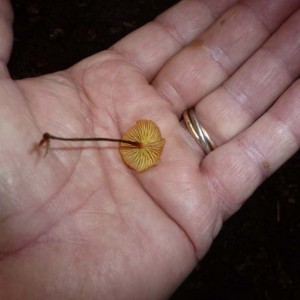
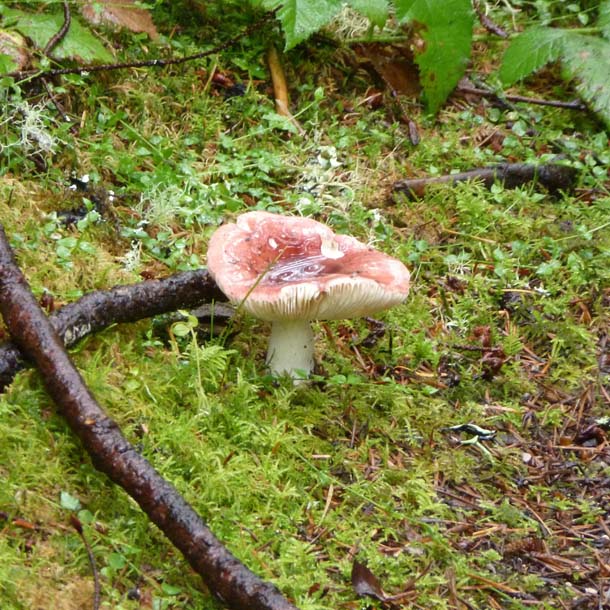
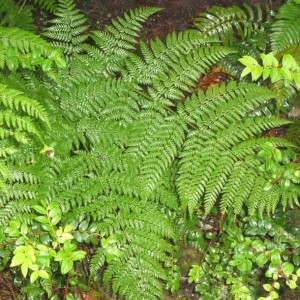
Odd name, “Old Pine Trail.” There are no pines here, only firs and a thick understory of huckleberry, thimbleberry, elderberry, and a variety of ferns, although sword fern always dominates. Our native California blackberry is also here, much gentler and less prickly than the Himalayan blackberry that invades our gardens in drier habitats.
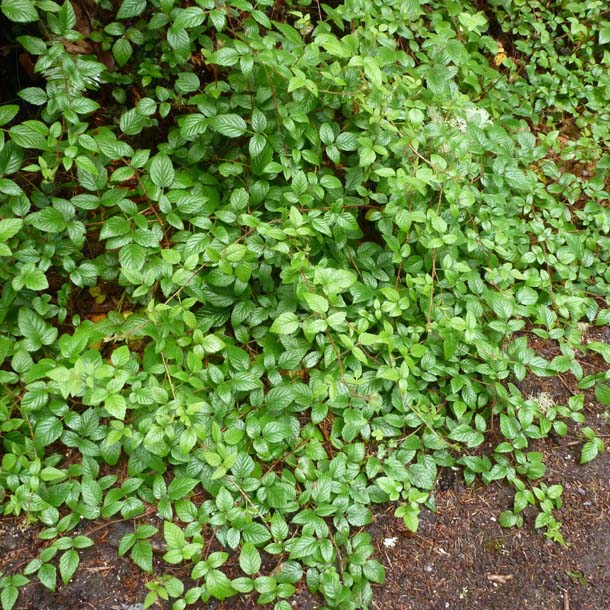
Reaching the Ridge Trail the forest opens up a bit, there is less fog drip, and the understory takes on some character of coastal scrub—drier more xeric. And the soundscape changes with the habitat. The bouncing song of the Wrentit, “the voice of the chaparral,” chimes in. The Wrentit is a true West Coast resident, restricted in distribution to the Pacific slope from the Columbia River to northern Baja. Unlike other sonbirds, the wrentits sing all year round.
Listen here:
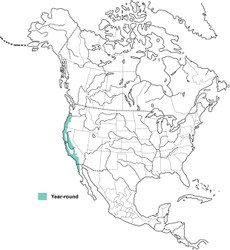
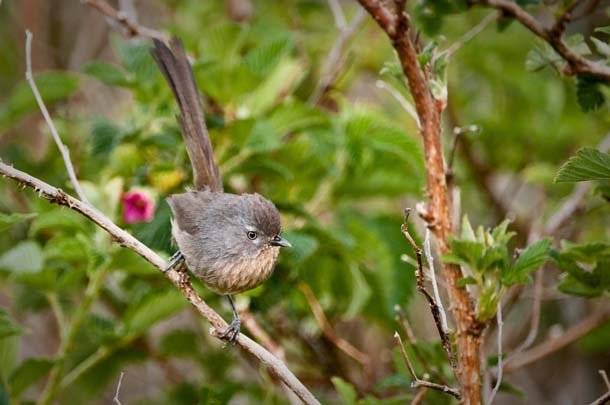
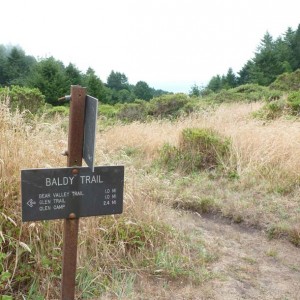
From the top of the Old Pine Trail, the Ridge Trail runs through an ecotone of Douglas-fir and coastal scrub. This is Gray Fox territory, and the fox have left calling cards of berry-rich scat along the trail’s length. One of these most feline of the canines jumps across the trail about as I approach and I see it’s fluffy tail, as long and as its slender body disappear into the coyote bush. From its junction with the Ridge Trail, the Baldy Trail is an easy downhill mile before joining the Bear Valley Trail, 1.5 miles west of Divide Meadow. Like the Old Pine Trail, the name is a misnomer. It may have been a bald hill at one time, but now its fairly densely vegetated. An Allen’s hummingbird zips out of some flowering honeysuckle and a purple finch eats the pink petals. Down slope the trail passes through what seems like an anomalous stand of live-oak, then the steady purling of Bear Valley Creek signal that I’m almost back.
Check out the Trail version of this hike, with map and Google map directions: Divide Meadow Loop—Old Pine Trail to Ridge Trail to Baldy Trail
Conditions: coastal fog, cool and damp, slight breeze.

